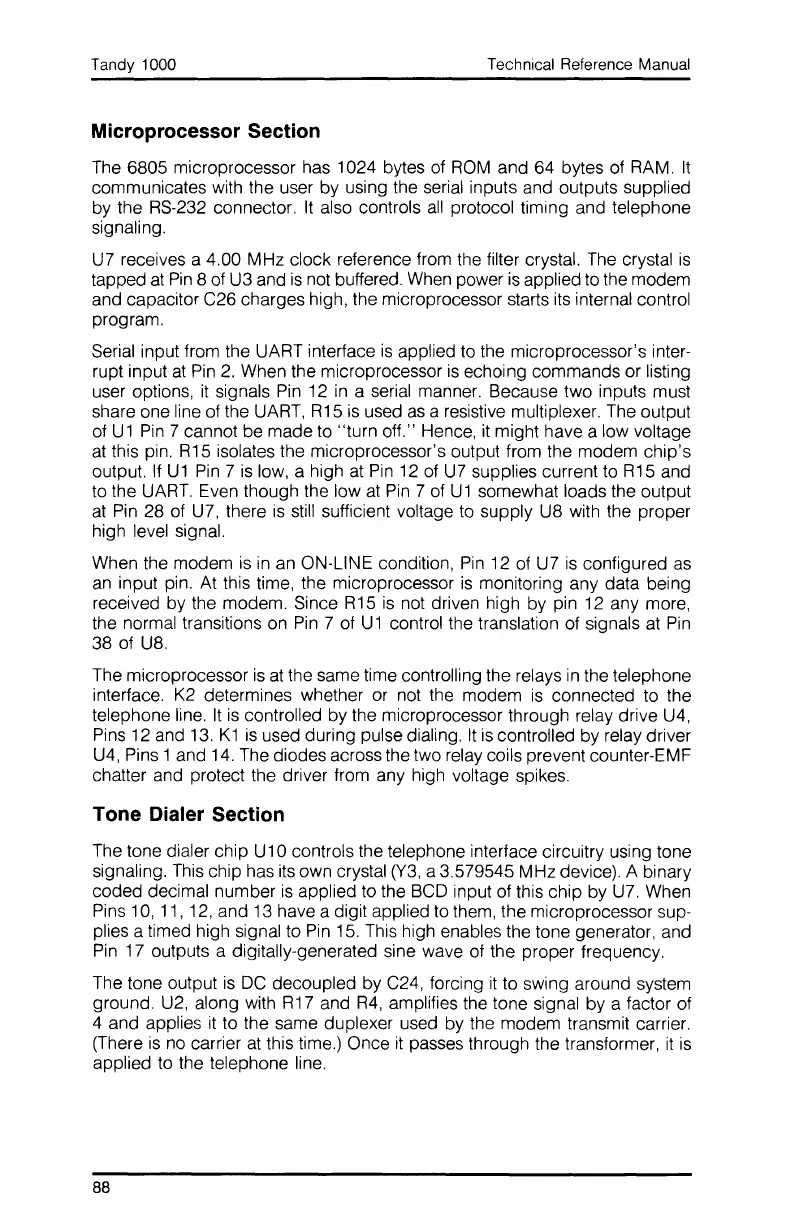Tandy 1000 Technical Reference Manual
Microprocessor Section
The
6805 microprocessor has 1024 bytes
of
ROM
and 64 bytes of RAM.
It
communicates with the user by using the serial inputs and outputs supplied
by the RS-232 connector.
It
also controls
all
protocol timing and telephone
signaling.
U7 receives a 4.00 MHz clock reference from the filter crystal. The crystal
is
tapped at
Pin
8
of
U3 and
is
not buffered.
When
power
is
applied to the modem
and capacitor C26 charges high, the microprocessor starts its internal control
program.
Serial input from the UART interface
is
applied to the microprocessor's inter-
rupt input
at
Pin
2.
When the microprocessor
is
echoing commands or listing
user options,
it
signals
Pin
12
in
a serial manner. Because two inputs must
share one line of the UART, R15
is
used
as
a resistive multiplexer. The output
of
U1
Pin
7 cannot be made to "turn off." Hence,
it
might have a low voltage
at
this pin.
R15
isolates the microprocessor's output from the modem chip's
output.
If
U1
Pin
7
is
low, a high
at
Pin
12
of
U7 supplies current to R15 and
to the UART. Even though the low
at
Pin
7
of
U1
somewhat loads the output
at
Pin
28 of U7, there
is
still
sufficient voltage to supply U8 with the proper
high level signal.
When the modem
is
in
an ON-LINE condition,
Pin
12
of
U7
is
configured
as
an
input pin.
At
this time, the microprocessor
is
monitoring any data being
received by the modem. Since
R15
is
not driven high by pin 12 any more,
the normal transitions on
Pin
7 of U1 control the translation of signals at
Pin
38 of U8.
The microprocessor
is
at
the same time controlling the relays
in
the telephone
interface.
K2
determines whether or not the modem
is
connected to the
telephone line.
It
is
controlled by the microprocessor through relay drive U4,
Pins 12 and 13.
K1
is
used during pulse dialing.
It
is
controlled by relay driver
U4, Pins 1 and 14. The diodes across the two relay coils prevent counter-EMF
chatter and protect the driver from any high voltage spikes.
Tone Dialer Section
The tone dialer chip
U1
0 controls the telephone interface circuitry using tone
signaling.
This
chip has
its
own crystal
(Y3,
a 3.579545 MHz device). A binary
coded decimal number
is
applied to the BCD input of this chip by U7. When
Pins 10,
11,
12, and
13
have a digit applied to them, the microprocessor sup-
plies a timed high signal to
Pin
15. This high enables the tone generator, and
Pin
17 outputs a digitally-generated sine wave of the proper frequency.
The tone output
is
DC
decoupled by C24, forcing
it
to swing around system
ground. U2, along with
R17
and
R4,
amplifies the tone signal by a factor of
4 and applies
it
to the same duplexer used by the modem transmit carrier.
(There
is
no
carrier
at
this time.) Once
it
passes through the transformer,
it
is
applied to the telephone line.
88
